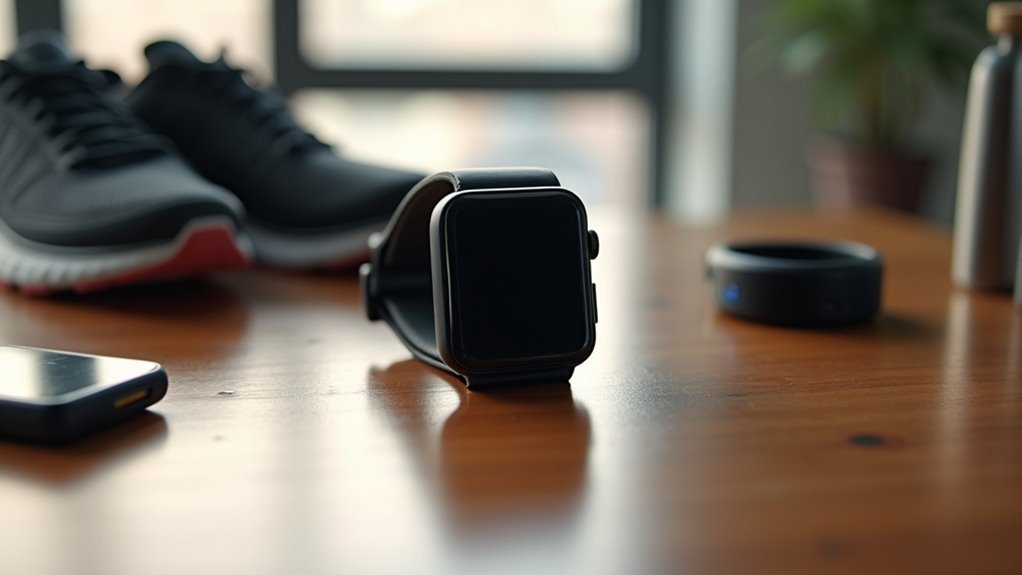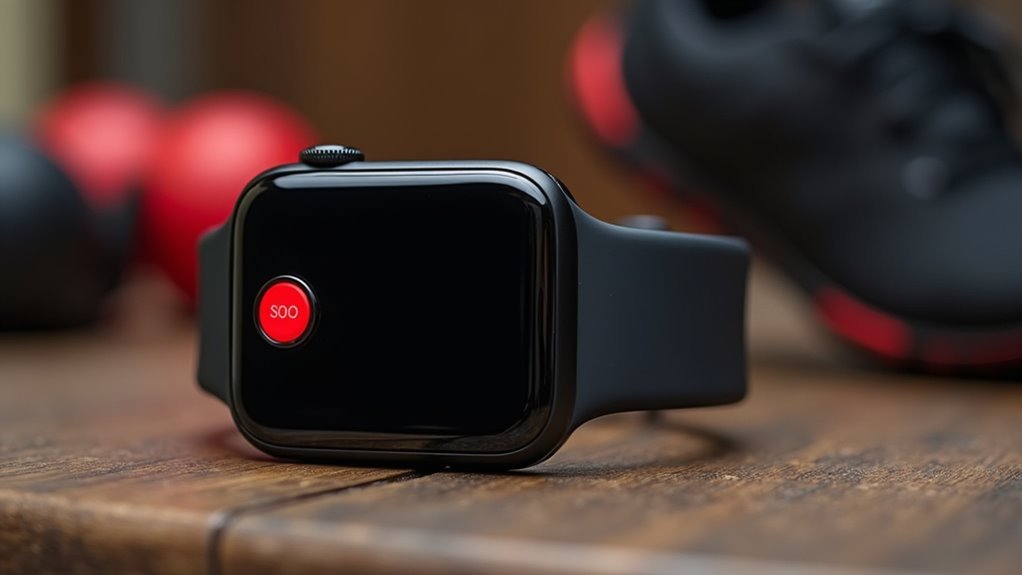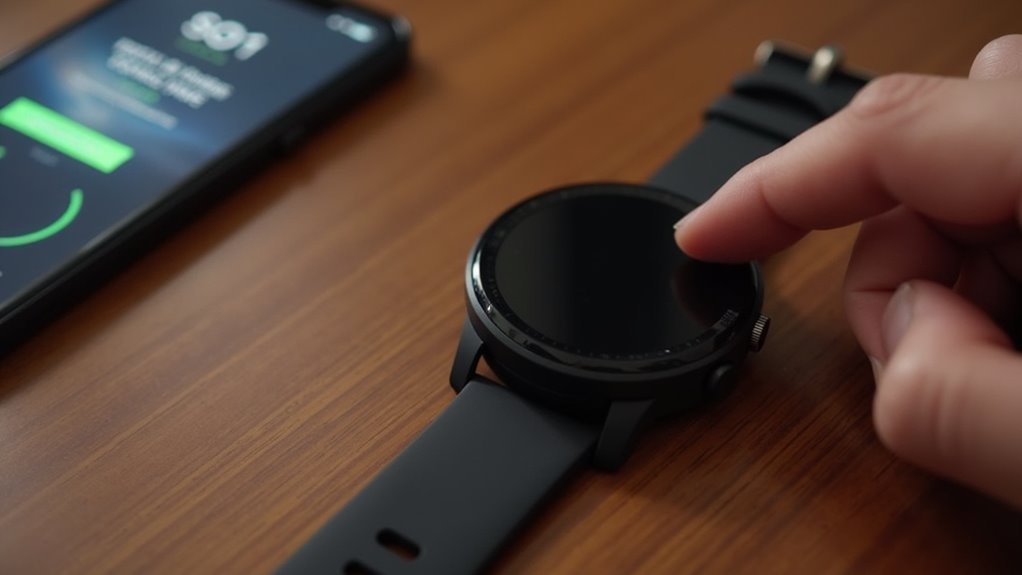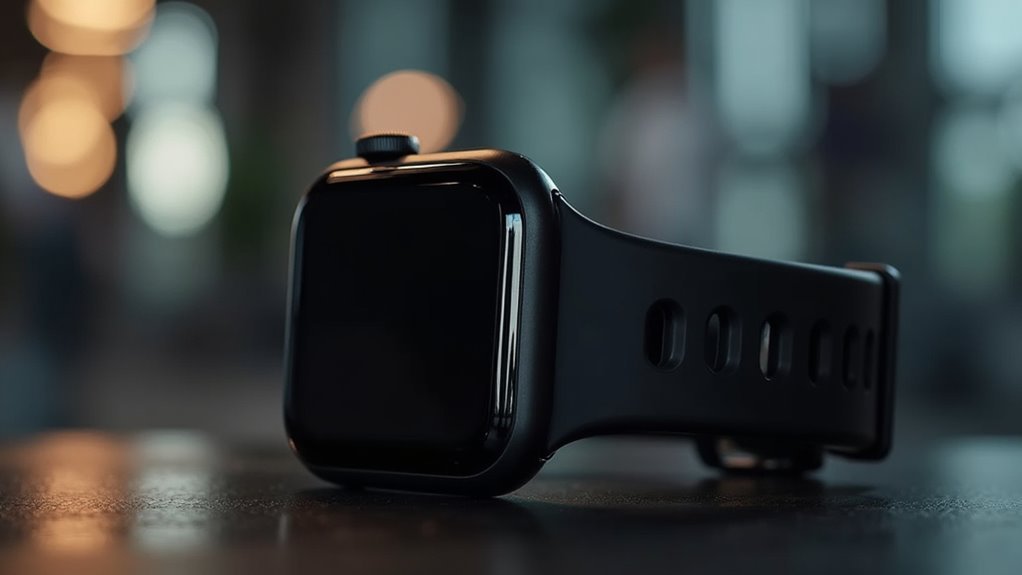Fitness tracker SOS features provide instant emergency assistance through dedicated physical buttons that connect you to help within seconds. Your device uses GPS and cellular networks to share real-time location data with emergency contacts and 911 services, while two-way communication allows direct calls through built-in speakers and microphones. Advanced models include automatic fall detection using accelerometers and gyroscopes, with customizable sensitivity settings and 30-60 second response windows before alerting contacts. Discover how these technologies work together for extensive safety coverage.
Understanding Emergency Alert Systems in Fitness Trackers

When emergencies strike, fitness trackers equipped with SOS features can become lifelines that connect you to help within seconds. These emergency alert systems work through multiple activation methods, typically involving a dedicated button press or app interface that instantly triggers your distress signal.
Once activated, your device establishes two-way communication with emergency services or your designated contacts, ensuring responders can assess your situation effectively. You’ll receive immediate feedback through vibrating or auditory alerts confirming your SOS message was sent successfully.
Two-way emergency communication ensures responders can properly assess your crisis while immediate device feedback confirms your distress signal reached help successfully.
The system’s customizable emergency contacts give you control over who receives alerts during critical moments.
Advanced devices integrate voice assistants like Siri, making activation even more accessible when you can’t physically operate your tracker. Many modern fitness trackers with SOS capabilities include built-in cellular SIM cards, allowing them to function independently without requiring connection to your smartphone for emergency assistance.
Location Sharing Technology for Emergency Response
During critical emergencies, your fitness tracker’s location sharing technology transforms from a convenience feature into a potentially life-saving communication tool. GPS satellites and cellular networks triangulate your exact coordinates, enabling emergency responders to pinpoint your location within seconds of receiving an SOS alert.
Your device automatically transmits real-time location data to pre-selected emergency contacts and 911 services when you activate the SOS feature. This eliminates the precious time typically lost when emergency operators must verbally confirm your whereabouts during stressful situations.
| Technology | Function | Benefit |
|---|---|---|
| GPS Triangulation | Pinpoints exact coordinates | Precise location accuracy |
| Cellular Integration | Transmits data to emergency services | Direct 911 communication |
| Real-time Sharing | Continuous location updates | Live movement tracking |
Advanced systems maintain location sharing even while you’re moving, ensuring consistent safety monitoring throughout any emergency situation. Professional operators facilitate two-way communication through your device’s built-in speaker system, allowing for immediate assistance coordination without requiring additional equipment.
Dedicated SOS Buttons and Physical Controls

While sophisticated location sharing technology forms the foundation of emergency response systems, the physical interface that triggers these life-saving features deserves equal attention.
The most advanced emergency technology means nothing if you can’t access it when crisis strikes.
You’ll find that dedicated SOS buttons provide the most reliable way to access emergency services when you need them most.
Most fitness trackers with SOS capabilities feature physical controls designed for quick activation:
- Hold-and-press mechanisms – You’ll typically hold the side button for 3-5 seconds to prevent accidental triggers
- Bright color coding – Many devices use red or orange buttons for immediate visual identification during emergencies
- Screen-free operation – You can activate SOS features without waking the display or maneuvering through menus
These physical controls eliminate the complexity of touchscreen maneuvering when you’re under stress, ensuring you can instantly connect with emergency contacts or services regardless of your technical familiarity. The water resistance of these SOS buttons ensures they remain functional even during intense workouts or adverse weather conditions when emergencies are most likely to occur.
Automatic Fall Detection Capabilities
Your fitness tracker’s automatic fall detection uses advanced sensors and AI algorithms to identify sudden movements that indicate you’ve fallen.
The system analyzes data from accelerometers and gyroscopes to distinguish between actual falls and normal activities like sitting down quickly or dropping your arm.
When a fall’s detected, your device will typically give you 30-60 seconds to respond before automatically alerting your emergency contacts or services with your location. Popular devices like the Apple Watch Series 10 offer enhanced fall detection alongside features such as sleep apnea detection and heart rate monitoring with improved battery life.
How Detection Works
When you take a tumble, your fitness tracker’s sophisticated sensor array kicks into action, using accelerometers, gyroscopes, and barometers to detect the sudden changes in movement, orientation, and impact that characterize a fall.
AI-powered algorithms analyze these movement patterns in real-time, distinguishing between normal activities and actual falls to prevent false alarms.
The detection process involves several key components:
- Impact sensing – Your device measures sudden deceleration and impact forces that exceed normal movement thresholds.
- Pattern recognition – Advanced algorithms compare detected movements against known fall signatures and anomalies.
- Rapid response – The system processes sensor data within seconds to trigger emergency protocols.
You can customize sensitivity levels to match your activity level, ensuring accurate detection whether you’re exercising vigorously or moving gently throughout your day. Once activated, the system provides a 60-second window with vibration and audible alarms before automatically contacting emergency services or designated contacts.
Accuracy and Sensitivity
Despite impressive technological advances, fitness tracker fall detection accuracy varies notably across different devices and real-world conditions, with studies showing detection rates ranging from 73% to 98%.
Your device’s performance depends on its sensor quality, algorithms, and brand-specific technology. While some advanced models achieve over 90% accuracy in controlled lab settings, real-world results are typically lower.
You’ll encounter challenges with false positives, as sudden movements can trigger alerts. Wrist-worn devices particularly struggle with this issue.
Device placement notably affects sensitivity—chest-worn sensors often outperform wrist-based ones. Your activity patterns and fall types also matter; sudden falls are detected more reliably than gradual ones.
Environmental factors like surface hardness and your movement habits can impact detection reliability, making individual results unpredictable. As with other biometric measurements, measurement capabilities have significantly improved over time, though inconsistencies still exist across different wearable fitness devices.
Alert Response Process
Once your fitness tracker detects a potential fall, it initiates a carefully designed alert response process that balances urgency with user control. The device immediately vibrates and sounds an alarm, giving you a response window of 30-60 seconds to confirm whether you need assistance.
The emergency response follows this structured approach:
- Initial confirmation: You can cancel the alert if it’s a false alarm by responding to the device prompt.
- Automatic escalation: If you don’t respond within the time frame, the tracker automatically contacts your emergency contacts.
- Location sharing: GPS coordinates are immediately transmitted to responders for quick assistance.
Throughout this process, your stored medical information becomes accessible to first responders, ensuring they’ve critical health data when providing assistance. Advanced models can establish emergency contact calls within 10 seconds post-fall detection for immediate response.
Two-Way Communication Features
While traditional fitness trackers focused solely on health metrics, modern devices now integrate sophisticated two-way voice communication that transforms your wearable into a powerful safety tool.
You can make and receive calls directly through your device’s built-in speaker and microphone, eliminating the need for your smartphone during emergencies.
When you trigger an SOS alert, emergency contacts can speak with you immediately, evaluating your situation in real-time. This feature proves invaluable during outdoor activities where phone access isn’t practical.
Your device automatically shares GPS coordinates during calls, helping responders locate you quickly.
The interface prioritizes simplicity – you’ll access communication through dedicated buttons or voice commands. Many devices include contact controls that allow you to pre-approve trusted contacts for enhanced safety during emergency situations.
Advanced models optimize speech quality despite background noise, ensuring clear conversations when you need help most.
Essential Setup and Configuration Steps

Before your fitness tracker can serve as a reliable lifeline, you must properly configure its SOS features through a systematic setup process.
Start by accessing your device’s settings through the connected app or directly on the device itself. You’ll need to establish your emergency contacts carefully, selecting individuals who can respond quickly during crisis situations.
Choose emergency contacts who are readily available and can act swiftly when you need help most.
The essential configuration steps include:
- Testing SOS functionality with your emergency contacts to verify proper operation
- Enabling fall detection if your smartwatch supports automatic emergency alerts
- Setting up GPS location sharing to include your current position in SOS messages
Remember to keep your emergency contact information current and regularly update phone numbers. Additionally, you should enter your medical details during setup to provide critical health information that emergency responders might need.
Many devices also allow you to customize activation triggers and set countdown timers before sending alerts.
Key Technologies Behind SOS Functionality
With proper configuration complete, your fitness tracker’s emergency capabilities rely on sophisticated technologies working seamlessly behind the scenes. GPS modules provide real-time location tracking, while assisted GPS enhances accuracy using cellular networks.
When GPS signals weaken indoors, Wi-Fi triangulation maintains positioning data.
Your device’s dedicated SOS button triggers immediate alerts without accidental activation. Built-in accelerometers and gyroscopes detect falls automatically, while AI algorithms interpret sensor data to minimize false alarms.
Machine learning adapts to your movement patterns over time.
Multi-network cellular connectivity guarantees broad coverage, supplemented by Bluetooth and Wi-Fi connections. Emergency alerts reach contacts through SMS, email, and app notifications simultaneously. Advanced devices feature two-way communication capabilities that enable clear conversations between users and their emergency contacts or caregivers.
Professional monitoring centers provide 24/7 response coordination, automatically contacting emergency services when needed.
Popular Devices With SOS Features
As emergency situations demand reliable response systems, several leading fitness tracker manufacturers have integrated extensive SOS features into their flagship devices.
You’ll find thorough emergency capabilities in premium models that prioritize user safety.
The Apple Watch Series stands out with automatic fall detection and side-button SOS activation that connects directly to emergency services.
Meanwhile, Garmin’s Fenix series offers incident detection sensors and manual assistance requests with real-time GPS tracking.
Garmin’s Fenix delivers comprehensive emergency protection through advanced incident sensors and GPS-enabled assistance features for outdoor adventurers.
Notable device categories include:
- Premium smartwatches – Apple Watch, Garmin Fenix 8, and Suunto Race offer dedicated SOS buttons and cellular connectivity
- Mid-range trackers – Fitbit Charge series provides emergency alerts through smartphone integration
- Budget options – Limited SOS functionality, typically requiring companion apps and phone connectivity
You should note that devices like Whoop 4.0 focus on health monitoring rather than emergency features. Budget trackers like the Xiaomi Mi Smart Band 9 typically lack comprehensive SOS capabilities due to their focus on basic fitness tracking rather than emergency response systems.
GPS Tracking and Cellular Connectivity
Two critical technologies power the most effective SOS features in modern fitness trackers: GPS tracking and cellular connectivity.
GPS uses satellite triangulation to pinpoint your exact location during emergencies, providing precise coordinates to emergency services. This technology calculates your position accurately, even in remote outdoor areas where you’re hiking or running.
Cellular connectivity enables your tracker to transmit SOS alerts independently, without requiring your smartphone nearby. LTE or 4G connections guarantee reliable network coverage for emergency communications.
When you activate SOS features, cellular technology immediately sends your GPS location data to emergency contacts or services.
Together, these technologies create a powerful safety net. Some trackers automatically detect falls and trigger SOS protocols, while others allow manual activation through dedicated buttons. Modern fitness trackers also monitor heart rate variability to assess recovery and overall health status during emergency situations.
Battery Life Optimization for Emergency Features
Your fitness tracker’s emergency features won’t help if the battery dies when you need them most.
You’ll want to master power management strategies that keep your device running during critical situations while understanding how emergency mode settings can extend operational time. Activating low-power mode during emergencies can significantly extend your device’s operational time by dimming the screen and reducing background activity.
Learning essential battery conservation tips guarantees your SOS features remain accessible exactly when emergencies strike.
Power Management Strategies
When your fitness tracker’s battery dies during an emergency, even the most advanced SOS features become useless.
That’s why implementing smart power management strategies is vital for maintaining reliable emergency functionality.
You’ll want to disable background app refresh and turn off unnecessary features that drain your battery without compromising SOS capabilities. Minimizing display brightness and choosing between vibration or sound alerts can greatly extend battery life during critical moments.
Key power conservation techniques include:
- Activating low power modes that automatically limit non-essential features while preserving emergency functions
- Turning off always-on display and background data to maximize battery longevity
- Keeping software updated to benefit from the latest power-saving improvements
For immediate battery issues, try performing a power off/on restart which may end background processes that are rapidly draining your device.
These strategies guarantee your SOS features remain operational when you need them most.
Emergency Mode Settings
Although standard fitness tracker settings prioritize convenience and connectivity, emergency mode transforms your device into a lifeline by automatically optimizing battery consumption for critical functions.
Your device will disable non-essential features like notifications, music controls, and apps while preserving GPS tracking, SOS communication, and essential sign monitoring. You’ll find that battery saver modes can extend emergency functionality up to 21 days on devices like Garmin watches.
Your tracker intelligently manages power consumption by reducing screen brightness, limiting wireless connections, and adjusting sensor frequencies. Emergency features vary significantly across different smartwatch brands, with reliable options including Apple, Garmin, Google, and Samsung for comprehensive emergency services.
This optimization guarantees you can send location data and maintain emergency contact capabilities when you need them most. You can customize these settings through companion apps, balancing emergency preparedness with your device’s everyday functionality and personal preferences.
Battery Conservation Tips
While emergency modes handle automatic power optimization, you’ll want to implement additional battery conservation strategies to maximize your fitness tracker’s lifeline potential.
These proactive measures guarantee your device remains functional when you need emergency features most.
Key conservation techniques include:
- Disable non-essential features like wrist-based heart rate monitoring, gesture backlighting, and always-on displays when heading into remote areas
- Manage connectivity settings by turning off Bluetooth and limiting smartphone notifications to reduce unnecessary power drain
- Optimize display settings through reduced brightness, shorter screen timeouts, and simplified watch faces without constantly updating elements
You should also avoid extreme temperatures during storage and activities, as heat and cold greatly impact battery performance. Additionally, charge your device to around 50% before venturing into remote areas for extended periods to prevent deep discharge issues.
Regular software updates guarantee your tracker’s power-saving algorithms remain optimized for emergency situations.
User Experience and Daily Operation
Even during high-stress emergency situations, you’ll find that SOS features on fitness trackers prioritize intuitive operation through dedicated physical buttons and streamlined touchscreen commands.
These buttons are strategically placed on the device’s sides for quick access, requiring a long press to prevent accidental activation. Your device’s display shows essential information with simplified navigation that’s accessible for all ages, including seniors.
During daily use, your tracker functions normally, providing fitness metrics alongside emergency capabilities without interference.
You’ll appreciate the water resistance and extended battery life that uphold SOS reliability across various conditions. Two-way voice communication lets you speak directly with emergency responders through your device, while visual confirmation icons guarantee you know when SOS is active. Modern SOS-enabled devices can function independently with GPS functionality and cellular connections, eliminating the need for a paired smartphone during emergencies.
Frequently Asked Questions
Can SOS Features Work Without a Smartphone Nearby?
Yes, you can use SOS features without your smartphone nearby. Some fitness trackers have cellular connectivity through SIM cards or eSIMs, letting them send emergency alerts independently and maintain functionality.
How Much Do Fitness Trackers With SOS Capabilities Typically Cost?
You’ll pay around $100-$159 upfront for fitness trackers with SOS features, plus monthly service fees ranging from $29.95-$46.95. Additional features like fall detection typically cost an extra $10 monthly.
Will False Alarms From SOS Features Result in Emergency Service Charges?
You might face emergency service charges for false SOS alarms, depending on your local jurisdiction’s policies. Fees vary globally, and you’re responsible for any rescue costs, not the device manufacturer.
Are SOS Fitness Trackers Covered by Health Insurance or Medicare?
You’ll typically pay out-of-pocket since most health insurance and Medicare don’t cover SOS fitness trackers. They’re considered consumer electronics, not medical equipment, though some wellness programs offer partial discounts.
Can Multiple Family Members Receive SOS Alerts Simultaneously?
Yes, you can set up multiple family members to receive SOS alerts simultaneously. Most fitness trackers send emergency notifications to all designated contacts at once via SMS, calls, and app notifications for faster response times.
In Summary
You’ll find that fitness tracker SOS features can truly be lifesavers when you’re in distress. Whether it’s automatic fall detection, dedicated emergency buttons, or GPS tracking with cellular connectivity, these devices keep you connected to help when you need it most. You’re investing in more than fitness monitoring – you’re gaining peace of mind. Choose a device that matches your lifestyle and emergency preparedness needs for ideal protection.





Leave a Reply